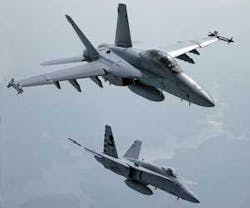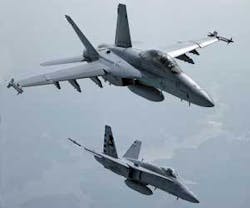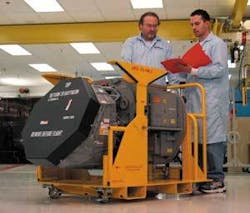By J.R. Wilson
PATUXENT RIVER NAS, Md. - Much of the attention surrounding full-scale military combat in recent years has focused on unmanned aerial vehicles (UAVs), precision-guided munitions, and fast-moving ground forces. That has been largely due to unquestioned U.S. air superiority and a lack of enemy air power.
The latter, however, cannot be considered a given for any future engagements, so ensuring continued U.S. air superiority against any foe has remained a keystone to U.S. Department of Defense (DOD) planning. With only two new combat platforms scheduled to enter service before 2020-the Air Force’s F-22 Raptor, which earned combat authorization in January, and the Joint Strike Fighter, which is still in development-that responsibility falls largely to legacy fighters such as the U.S. Air Force F-15 and the Navy/Marine Corps F/A-18.
Keeping those two veterans at the top of the global air armadas has meant a considerable investment in new, primarily electronic, technologies. As the newer of the pair-and the first designed from the start for technology insertion-the F/A-18 has seen the most dramatic gains in capability.
The most advanced version to date is the F/A-18 E/F (Block Two). The first Super Hornets entered service in November 1999 with 17 cubic feet of electronics “growth space” for next-generation avionics. Block Two is making good use of that design feature with a host of upgrades, including:
- Active Electronically Scanned Array (AESA) radar;
- Advanced Targeting Forward-looking Infrared (ATFLIR) system;
- Joint-helmet Mounted Cueing System (JHMCS);
- Multifunctional Information Distribution System (MIDS);
- advanced aft crew station;
- Fibre Channel switch for increased data processing capability; and
- integrated weapons systems and sensors for reduced crew workload and increased capability.
While each gives the Super Hornet significant new advantages over any other aircraft it might encounter in the next two decades, one of the most dramatic force multipliers is AESA.
“With mechanically scanned radar, the array moves back and forth and you see targets when energy is reflected,” says Capt. Aaron Bowman, the Navy’s AESA program manager. “If you wanted to shoot a weapon, that occasional target update is not good enough to support the weapon, so we would have to focus entirely on that one target. If I had multiple targets, I had to identify which one I wanted to target and focus all my energy on it.”
Because the AESA radar can move the beam around so quickly, it can maintain a good quality of track on more than one target. “I can pick multiple targets at the same time; I can’t get specific on how many we can do at a time, just that it is more than one,” Bowman says.
AESA designers took advantage of many (COTS) components. “Our goal was to go out and buy a new radar for about the same price as the existing, but with a five times approved reliability over the APG-73,” Bowman says. “We have liquid cooling and all the latest, state-of-the-art technology. Performance is very key, as is growth. We’re only touching the surface of where we are going with this radar. We have a growth plan for increased technologies and improved capability over the next 10 years.”
The APG-79 AESA radar has been an unusually accelerated program, moving from initial contract in 2000 to two years of flight tests to first delivery of a fleet aircraft in December 2005. Achieving that required modifying the airplane, building the radar from the ground up, and writing hundreds of thousands of lines of code, explains Bill Gardner, AESA program manager at prime contractor Raytheon Space and Airborne Systems, Air Combat Avionics, in El Segundo, Calif.
The result of that effort is difficult to quantify-replacing a mechanically scanned radar (the APG-73), which can only look in one direction at a time, with an electronic beam that can look in different directions more than a thousand times per second.
As a result, the F/A-18 E/F can maintain a constant check on other aircraft, in all directions, while simultaneously tracking objects on the ground. Even more importantly, it can pass targeting information to several air-to-air and air-to-ground weapons-those it is carrying and those of other aircraft not equipped with AESA.
“With the Block Two F/A-18 E/F, the whole idea is sharing information and being on the network,” Bowman explains. “This radar can provide the F/A-18 with self-targeting capability, but a non-AESA aircraft also will be able to drop ordnance based on information provided by an AESA-equipped aircraft. The Super Hornet has multi-source integration and a fused, integrated display, so a single-seat F/A-18 pilot can have side-by-side displays or alternate between them, as he wishes. For the most taxing missions, you will have a backseater doing a lot of that work.”
The technology that changes procedures as much as AESA itself is the ability to change the way the crew can use the whole weapons system. “We can overlay (the radar image) on a high-resolution map, so we can not only see the movers on the ground, but the roads they have,” Bowman says. “The operations folks will be able to develop entirely new tactics based on this aircraft. With all these options and flexibility available, we are excited to see what comes back from them.”
AESA also has demonstrated a significant influence on the capabilities of some of the Navy’s newest air-launched weapons-the Advanced Medium-Range Air-to-Air Missile (AMRAAM), Joint Direct Attack Munition (JDAM), and Joint Standoff Weapon (JSOW). In addition to transmitting real-time targeting data to several weapons at the same time, AESA also has a much longer (classified) range than its predecessors, making it possible, for the first time, for these new weapons to attack targets at their own maximum ranges.
“We have done multiple JDAM tests and have some multiple AMRAAM shots coming,” Bowman relates. “At the end of August 2005, we did our first JDAM-taking off from base with nothing, designated a target, passed that target to the weapon, and released the weapon-a capability we currently don’t have in the fleet.” Previously, he says, an F/A-18 had to do mission planning before takeoff or have it passed to the pilot en route; the radar was not accurate enough to designate its own end point on the ground.
“AESA changes that, allowing us to take off, find our own targets and attack them without any external help,” Bowman says. “The AMRAAM achieved a range never before reached by an F/A-18. AMRAAM’s motor can burn longer than we ever approached using, but now we can see at long enough ranges to use that capability. That’s the unclassified way of saying the weapon can now fly farther in actual application. What’s important there is that we are not driving new requirements on AMRAAM; we were just never able to use what it already provided.”
Capt. David “Decoy” Dunaway, program manager for Precision Strike Weapons at the Naval Air Systems Command (NAVAIR) at Patuxent River Naval Station, Md., says AESA also will make JSOW-one of the most heavily used weapons during Operation Iraqi Freedom-into an extremely accurate, time-sensitive strike weapon against land and sea targets. The combination is especially appealing with the new JSOW-C variant, the first with an onboard targeting template generator.
“The F/A-18 E/F/G, with AESA, can take a SAR (Synthetic Aperture Radar) map, run it through an algorithm on the aircraft, georegister, and run it through the DPPD (digital point precision database), send that to the weapon, and fly it out to the target in seconds,” he says, adding that funding for that capability is anticipated in the 2008 DOD budget. “That would take a four-hour timeline down to minutes-you are basically a weapon’s time-of-flight in minutes away.”
Bowman says AESA’s ability to provide that kind of force multiplication can be applied to any GPS-guided munition-and any platform on the evolving Global Information Grid (GIG).
“I can think of several scenarios where it would work fine with three other aircraft,” Dunaway says. “Our AESA roadmap is long and it will be awhile before we have them all fielded, but, in the interim, having just a few out there will help the entire Navy. When you start thinking network ops, just as easily as I can provide that information to a group of aircraft I’m flying with, I can also pass it to the GIG, which can then pass it to ground, ship, and surface forces.”
The technologies involved in AESA are more evolutionary than revolutionary, with elements coming from a variety of current military applications as well as COTS components. The F-15 Eagle jet fighter has been flying with an air-to-air only version of AESA for several years, while the AN/APG-77 AESA was designed in the early 1990s for the Raptor.
The core technologies of the Super Hornet version-solid-state non-gimbaled transmit/receive (T/R) modules, multi-channel receiver/exciter (R/E) with programmable waveforms, ruggedized COTS-based common integrated sensor processor-now will be leveraged into other platforms as part of the Multiplatform Radar Technology Insertion Program (MP-RTIP).
At the core of the new system is an advanced resource manager with the ability to control the radar assets-array, receiver, waveform generator-to support air-to-air target detection and track, air-to-surface, search-and-rescue, sea surface search and track, weapon support, etc.
“There were several fundamental enabling technologies,” Gardner notes. “The fundamental design that exploited the benefits of an agile beam AESA; our latest T/R module technology, centered around a tiled array that enables low weight and high reliability; a new R/E, with advanced analog-to-digital conversion and waveform generator; and a fundamental architecture based on a commercial Fibre Channel standard.
“We wanted to leverage advances in the commercial sector, which mitigate against parts obsolescence,” Gardner continues. “Having done that, we were able to make the system affordable. The design guidelines were affordability, high performance, high reliability, upgradability, and growth opportunity. So the other critical technology is the isolation layer between the applications software and hardware, enabling us to continue to upgrade application-level software without impacting the lower level, basic operating system or causing obsolescence at the processor level.”
Raytheon also says the ultra-thin antenna, with an array that weighs about 95 pounds, has a 15,000-hour mean time between critical failures (MTBCF) rate on the array and 1,250 hours on the system, with no maintenance predicted for 10 to 20 years. It also features a modular weapon replaceable assemblies (WRA) design for faster, easier hardware and software module repairs, along with built-in testing, to significantly reduce total ownership costs.
“We’ve designed the radar to be resistant to parts obsolescence, so as the Navy evolves its roadmaps toward more advanced capabilities, we will be consistent with that,” Gardner adds. “At some point, the processors also will need to grow, so we’ve used standard interfaces to integrate form/fit/function to upgrade to new processors in the future.
Future processors will help integrate the Super Hornet into network-centric operations so that the aircraft’s processors, synthetic aperture radar resolutions, and core sensor data are available to the network. “In a general technology view, we look at next-generation algorithms for target tracking and a core technology development for target recognition,” Gardner says. “We try to integrate new sensor technology, such as the ATFLIR on the Super Hornet, with the AESA radar and ensure future opportunities to do that.”
AESA’s multifunction array uses a tile-based packaging approach for the 1-by-1-inch T/R modules, which are integrated into the X-band phased array to create an extremely narrow aperture front.
“The challenge was to get ever higher density packaging,” Gardner says. “We reduced the modules from 16 to 4 and reduced weight significantly. We also have advanced diagnostics down to the card level. The R/E enhances the signal from the array and the motion sensor subsystem mitigates the adverse effects of motion and vibration, enabling high resolution.
“In the common integrated sensor processor, we have a common PC design, centered around commercial standard Fibre Channel interfaces and a 32-channel switch that gives us a very high speed interface and the ability for growth and future capabilities.”
The strong emphasis on growth and upgradability reflects the military’s determination to change its long practice of locking down a system design as much as a decade before the first platform enters flight tests, then trying to keep that aircraft in service for several more decades. With the fast pace of commercially driven technology seeing new processor generations every 18 to 24 months and entire system overhauls about every three years, that approach is no longer tenable.
“We’re looking at 2014-15 to complete all AESA deliveries to the fleet. Assuming we get approval for Lot 30, which is coming up soon, every aircraft off the line after that will have an AESA in it,” Gardner says.
“That’s a long time, in technology terms, which is why we have so much growth capability. With that excess processing capability and the contractor interest in using the latest and greatest technologies, we will continue to mature, develop and grow the entire time this is being done-and even afterward. So we won’t have a stagnant or outdated system by the time we complete deliveries.”





